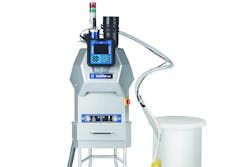Eliminate traditional hot-melt adhesive challenges
Hot-melt adhesive plays a big role in packaging. It’s done so for decades. But the heated tanks typically used in adhesive applications are proving less efficient than recently introduced "tank-free" systems.
Traditional melters often require char-induced maintenance. Related unplanned downtime and lost production can cost thousands of dollars each year.
The tank-free solution eliminates hot-melt adhesive equipment drawbacks. It increases packaging line uptime and hot-melt adhesive application efficiency. Material-usage monitoring and system performance improvement lead to better adhesive cost management.
Some like it hot
Package and container sealing is part of the complexity of today’s manufacturing processes. A system that quickly delivers consistent applied adhesive has a place in streamlined packaging lines and many companies apply hot-melt adhesive in packaging.
Systems that feature heated tanks, however, have limitations that include long startup times, adhesive charring and contamination, nozzle plugging and potential danger or discomfort to operators.
Heated tanks can take more than half an hour to reach operating temperature. Tank systems maintain large volumes of molten adhesive for hours or days at a time, and the level of molten glue tends to vary widely. Long heat soaks and varying molten glue levels are what lead to charring, or overheated and burned adhesive.
Adhesive on sidewalls, exposed to the atmosphere, chars quickly. Charred material leads to nozzle plugging and cleaning. Excessive charring also leads to premature fluid-seal failure in pumps and guns.
Nozzle plugging is problematic in traditional tank operation. As a plugged nozzle typically must be repaired when hot, removing nozzle plugs can be dangerous.
Heated tank systems require routine cleaning and maintenance to avoid excessive char buildup. Cleanouts are labor intensive and time consuming. Especially larger tanks generate significant wasted materials whenever flushing is necessary.
Operators are at risk when in close proximity to hot adhesive and system components and at the least must bear the unpleasant smell of hot and charring adhesive.
Finally, traditional tank systems are susceptible to hot-melt adhesive contamination. Exposure to the environment, combined with manual filling, allows dust and debris from the facility to enter the tank. Foreign material reduces adhesive effectiveness and increases the chance of nozzle plugging.
Darn big difference
Tank-free systems use a vacuum feed to draw adhesive pellets into heating chambers. Pellets are melted on demand and dispensed quickly, without overheating. By reducing the amount of adhesive exposed, heating times are fast. The Graco InvisiPac Hot Melt System, for instance, warms adhesive to operating temperature in less than 10 minutes.
While traditional heated tanks store anywhere from 4 to 50 liters of adhesive material, tank-free designs heat less than 2 liters of adhesive at a time. The Graco InvisiPac HM25 melter has a capacity of just 0.7 liters with maximized heating-element surface area, giving it the highest melt-rate per unit volume and quickest startup time on the market.
Shortened exposure of adhesive to heat in vacuum-based systems also reduces char formation. Less time at temperature results in less adhesive char. With a minimal melted volume, hot adhesive is dispensed quickly and replenished with a fresh supply. Char reduction leads to less material waste, fewer nozzle plugs, less overall system maintenance, longer fluid seal life and less production line downtime.
An operator no longer has to hand-fill hot melt pellets, and the task of tank scraping is eliminated. Reduced odor provides an overall better operator experience.
Finally, the vacuum-feed system keeps the ambient adhesive contained and closed from the outside environment, reducing chances of material contamination. Barring contaminants from the adhesive improves the dispensing process and helps ensure consistent adhesive application.
Intelligent monitoring
Traditional hot melt tank systems lack intelligence as to adhesive use, a vital piece of information in tracking packaging expenses. Today’s systems have an intuitive user interface and USB-downloadable operating data, making it possible to track material usage for a given time period. Managers know adhesive use over a single shift, a product run or otherwise. Better information leads to improved record keeping, materials requirements planning and packaging process control.
Knowing the facts about fluctuations in adhesive temperatures, system errors and key events supports packaging-line optimization. Supervisory control and data acquisition, along with remote monitoring, enables access to operating data from anywhere in the world, to empower decisions that improve efficiencies and control costs.
Some packaging companies are transitioning to more expensive, temperature-stable adhesives in an attempt to negate some hot-melt tank deficiencies. While these adhesives offer value, adhesive choice should not be dictated by the processing equipment. Tank-free systems accommodate the broad spectrum of adhesives used. All packaging grade adhesives are available, including metallocene, EVA and others, expanding the options for packaging managers.
Final words
Adhesive materials once viewed as incompatible with heated-tank systems due to brief pot-life stability or tendency to char are now viable options for use with tank-free systems. Viability and affordability further expand adhesive options. By exploring additional adhesive options, packaging managers may find savings in both the cost per pound of inventory ordered and the actual amount consumed per unit produced.
Traditional hot-melt adhesive dispensing systems, while playing a large role in the packaging process, suffer from inefficiencies and weaknesses. Emerging technologies eliminate many drawbacks of traditional heated tank systems and improve packaging efficiency. Advances in hot-melt dispensing are a benefit to production managers, reducing downtime, lowering adhesive costs and improving operator experience and information management. Results generate return-on-investment in tank-free hot-melt adhesive delivery.
Nick Long is a senior global marketing manager at Graco Inc., Advanced Fluid Dispense. Graco is a Minneapolis, Minnesota-based maker of fluid-handling systems and equipment.
